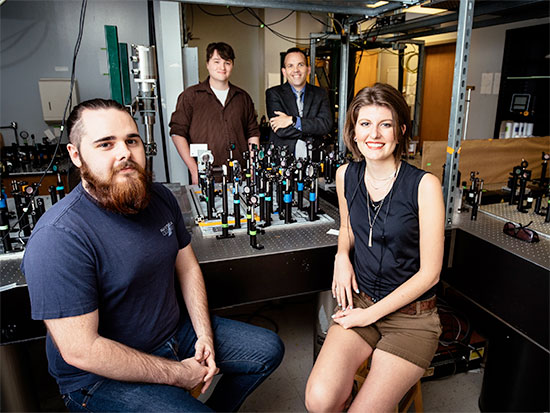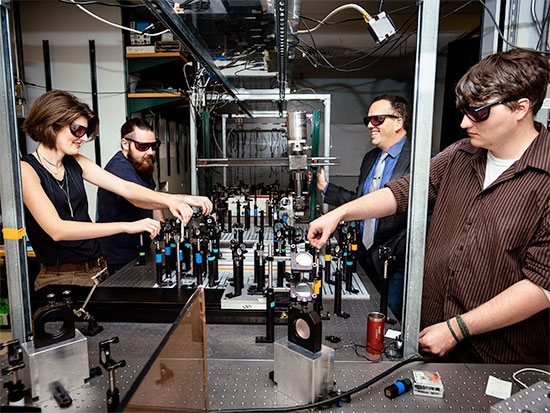 From front row, left: Andrew Pope, Ashlyn Burch, Tracy Hasting and David Hilton, Ph.D.Energy is both a commodity and a necessity for developed nations like the United States, and the always growing energy needs here at home and around the world demand improvements in how efficiently it is used.
From front row, left: Andrew Pope, Ashlyn Burch, Tracy Hasting and David Hilton, Ph.D.Energy is both a commodity and a necessity for developed nations like the United States, and the always growing energy needs here at home and around the world demand improvements in how efficiently it is used.
The University of Alabama at Birmingham Department of Physics was awarded $635,964 from the United States Department of Energy to continue research into improving the control and efficiency of energy production, storage and use by connecting theoretical and experimental physics of superconductor materials to find more proficient ways to transport energy.
“Right now, a significant amount of the electrical power that is generated in a power plant never makes it to your home. It is lost to the resistance of the copper and aluminum wires that deliver it,” said David Hilton, Ph.D., associate professor in the UAB College of Arts and Sciences and co-principal investigator of the DOE grant. “In theory, if we could replace copper cables with a superconducting material that has no resistance, we could better harness the power already being generated. While these materials exist, there are a lot of technological barriers to using them like this.”
Superconductivity has been known for nearly a century. Current conductors lose energy because of their electrical resistance. Superconductors, however, are a class of materials that have no electrical resistance and, thus, do not use lose energy. These are of limited use, however, because it takes extremely cold temperatures for superconductors to work.
“In our work, we are going to study a class of iron-based superconductors that were discovered about a decade ago,” Hilton said. “These would be easier to use in commercial applications, but there is still a lot of work to be done before that can happen.”
These iron-based superconductors might also have medical applications that would help lower the cost of commonly used instruments. A magnetic resonance image machine, or MRI, for example, is an instrument that uses a superconducting magnet to generate the magnetic field.
“Some of the cost of that instrument, both in initial cost as well as in operational costs, is the direct result of the need to keep the magnet at these extremely cold temperatures,” Hilton said.
 A team of UAB physicists builds an experiment to test superconductivity in a class of materials that are thought to have no electrical resistance. If a more cost-efficient superconducting magnet that is easier to chill could be designed, for example, it could reduce costs and allow patients greater access to MRIs. Physicians in rural areas of America or in developing countries may then be able to better diagnose and treat patients with access to a low-cost MRI machine that does not have to be chilled to extreme temperatures.
A team of UAB physicists builds an experiment to test superconductivity in a class of materials that are thought to have no electrical resistance. If a more cost-efficient superconducting magnet that is easier to chill could be designed, for example, it could reduce costs and allow patients greater access to MRIs. Physicians in rural areas of America or in developing countries may then be able to better diagnose and treat patients with access to a low-cost MRI machine that does not have to be chilled to extreme temperatures.
“The problem is that we have a poor fundamental understanding of why these materials are superconductors and how they work at such vastly different temperatures,” Hilton said. “This makes it very hard to predict what materials would be better than what we already have. Our work will be a series of experiments and computer simulations that try to explain what is happening and how we can use laser light to manipulate them. Non-equilibrium techniques can drive the material to do what we want it to do, instead of taking the material for what it wants to be. Understanding the basic laws of non-equilibrium physics is a frontier area in physics and, in particular, in superconductors.”
In addition to Hilton, this research will be conducted by UAB graduate students Ashlyn Burch and Tracy Hastings, alongside the theoretical research group of Ilias Perakis, chair of the UAB Department of Physics. UAB researchers will also collaborate with the faculty and staff at the National High Magnetic Field Lab at Florida State University, Los Alamos National Lab in New Mexico and Lawrence Berkley National Lab in California. New experiments will be built here and taken to the National High Magnetic Field Lab in Florida to be conducted with the new Split Florida-Helix magnet, a one-of-a-kind 25-Tesla magnet.
“The end result that we hope for is a better understanding of these materials and a better understanding of how to do this type of manipulation,” Hilton said. “We know that we can drive materials into non-equilibrium phases with lasers, but we are at the stage where this is very hard to understand. We want to be able to understand our experiments at a fundamental level to better understand the physics behind them, then run large-scale computer models to help us predict what will happen under these conditions. This grant is all about learning how to control matter at the quantum level.”